Friday Frivolity no. 21: I Need to Lie Back to Front With Someone Who Adores Me
How word art blurs the line between text and image, "soft start-ups," graceful surrender, and tea in the shower.
This is an installment in the section Friday Frivolity. Every Friday, you’ll get a short essay, plus a moodboard, 3 things I’m currently in love with, words of wisdom from what I’ve been reading lately, a little shimmer of poetry, a “beauty tip,” and a question to spark thought.
—
I Need to Lie Back to Front With Someone Who Adores Me
“The word is the picture of things” is an epigram attributed to the Greek poet Simonides of Ceos, who also once said, “Painting is silent poetry, and poetry is painting that speaks.” In our own society, it is a commonplace that “a picture is worth a thousand words,” and indeed we are dominated by pictures. Images come at us every which way. There is no escape from them. Writing in 1985, Italo Calvino observes that “Nowadays we are bombarded by so many images that we can no longer distinguish direct experience from what we’ve seen for a few seconds on television.”1 Television? Ah, how innocent one was back then!
Once upon a time, our imaginations mostly consisted of images we ourselves had witnessed, times we had lived through ourselves, places we had walked in ourselves, people we had seen with our own eyes, and maybe a small smattering of what we could fashion, vague and hazy, from someone else’s descriptions, someone’s travelogues or histories, someone’s made-up stories, someone’s perhaps very lifelike paintings, but still never totally concrete, never fully embodied, never vivid and real. Now “the flood of ready-made images” that daily swamps our imagination is unavoidable; we all contribute to it, and we are all victim to it. We move in a kaleidoscope of dreams. Between “the word is the picture of things” and “a picture is worth a thousand words,” we are more inclined to agree with the latter.
And yet a word contains worlds, can bring to life pictures that never were and never can be, draws behind it a dragnet of associations, abstractions, philosophies, feelings. Seeking to escape the total domination of the image, artists like Jasper Johns and Cy Twombly began to insert letters and words and phrases into their paintings, and then words became art in and of themselves, flexing their typographical muscles, shedding the old rags of image to stand alone: logos unbound. They shouted things about power and ideology like political slogans, wormed their way into our psychology like ads and billboards, and united those unlikeliest of pals, poetry and capitalism, in consumer products like T-shirts and condoms. Projecting phrases onto buildings, embossing them onto jeans, these voiceless objects were made to speak, and what they spoke was like something from their own inner soul or mind.



Writing about Twombly, Roland Barthes distinguishes between “the message, which wants to produce information, the sign, which wants to produce an intellection, and the gesture, which produces all the rest (the ‘surplus’), without necessarily wanting to produce something.” Poetry always exists in “the gesture,” which is what the best word art becomes: something more than information or intellection, something that communicates something beyond itself without knowing what that something is, without intending one specific effect, one confined action, one linear point from A to B, like advertisement or propaganda. “The vague is alive,” says Barthes.2
I am most interested in word art that expresses something diaristic, something vulnerable, something private, a confession or a love note. You read, and you are spoken to, you become the beloved writ large, the “you” of all poems, the forever referent of all thought; you read, and you speak, you become the lover, the eternal subject, the vertical pronoun that towers as a skyscraper does. How embarrassing it is to have one’s innermost thoughts scribbled across the wall of the world! And at the same time there is a pleasure in it, a kind of release. I do want someone to see me, not my image or my outer, visible casing but my invisible desires, my silent longings, all those yearnings I squirm to say aloud. I want them to be known, shouted from the rooftops, and for everyone to hear, and agree, and nod, and feel my feeling with me. “I NEED TO LIE BACK TO FRONT WITH SOMEONE WHO ADORES ME,” says one of Jenny Holzer’s projections. And by God, Reader, I really do.
Mood Board of the Week
(left to right, top to bottom)
Jenny Holzer x Helmut Lang, 2000: American artist Jenny Holzer and Austrian fashion designer Helmut Lang first collaborated on Lang’s fragrance brand in 1996, then continued to collaborate until Lang’s retirement from fashion in 2005. To mark the launch of Lang’s first fragrance in 2000, they created these ads that rejected models, colors, images, logos, pictures of the perfume itself, instead relying on the black-and-white impact of Holzer’s text. Only the last line, “I smell you on my skin,” really gives you a hint—the merest whiff, if you will.
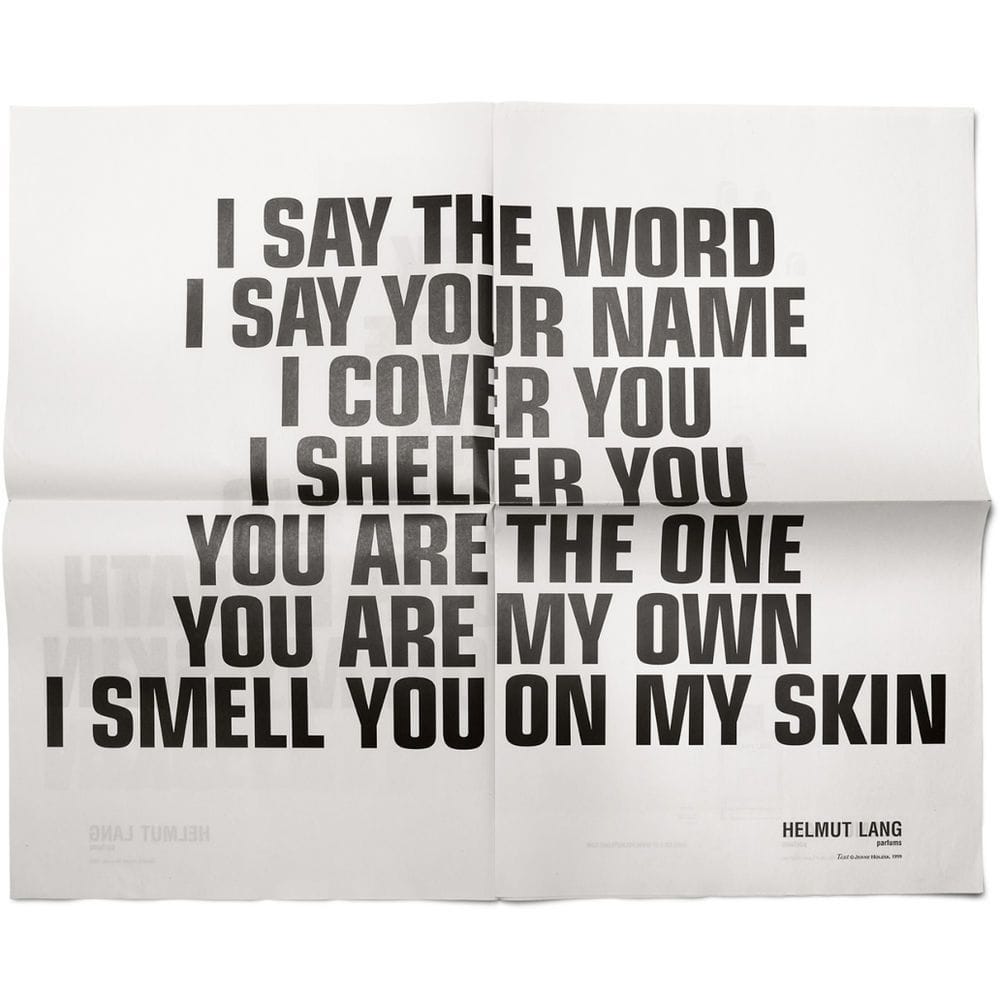
Jenny Holzer x Helmut Lang Robert Barry, Something That Needs Something Else To Survive (2011): “Nothing seems to me the most potent thing in the world,” American artist Robert Barry (1936–) once said. Part of the original Conceptual group, his art deals with the invisible, the unknown, the imperceivable, raising questions about the physical limitations of the art object and its relationship to space and time. The text here is thus spare and minimalistic, ambiguous, an open question. “Something that needs something else to survive.” Is that not precisely the condition of being in the world?
Tracey Emin, I listen to the Ocean and all I hear is you (2011): I love the neon wall art of British artist Tracey Emin (1963–). Her art—words, drawings, messy beds, and all—often deals with themes of intimacy, love, sex, the body, trauma, and womanhood. I like how Emin uses her own handwriting, giving the text the sense of a diary entry or personal note, the soul’s little voice battling against darkness.

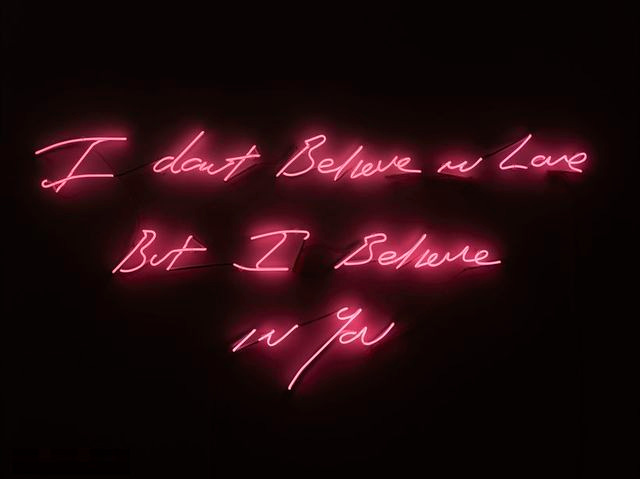
Tracey Emin, 1996 and 2012 silkenweinberg on Tumblr: I saw this floating around Tumblr like a disembodied prophecy. “My desires are god’s promises.” It could be a wish, a hope, an assertion, a defiant declaration. All of these texts express desire in one way or another, but what is a desire, where does it come from, who puts it in you, if not something we might call God?
Cy Twombly, Wilder Shores of Love (1985): I featured American painter Cy Twombly’s work a little bit in my Iliad post with his Fifty Days at Iliam—I’ve always loved his dynamism, speed, chaos, color, vibrancy, and I’ve always been fascinated by the use of words and phrases in his paintings. “You can imagine what those scribbles and what those words mean, and make them speak to you and translate to yourself,” filmmaker John Waters once said of Twombly. To me “Wilder Shores of Love” translates to tenderness, newness, exploration, excitement, that peculiar onrush of falling in love. The canvas seems too small to contain the text, which hurtles out of frame, searching, indeed, for a wilder shore.
Jenny Holzer, Projections, photographed by Attilio Maranzano (2001): Holzer’s work centers around word art and public spaces, often involving large-scale installations like billboards and projections onto buildings. This projection (I need to lie back to front with someone who adores me) was done in Berlin, and the combination of white text and blue dark blue backdrop makes it haunting, melancholy, otherworldly. Look a little closer, and you’ll notice a small cross: the building projected onto is a church, St. Matthew’s Church, built in the 1840s. The projection yokes together sacred and secular, old and new, public and private, with the force of a screamed secret, a megaphoned confession.
Tommy Coleman, seeing you blush (2011): Tommy Coleman describes himself as an “interdisciplinary artist and educator,” and his work often investigates intimacy, anxiety, and the boundaries between public and private. I like how the blush-pink of this print echoes its words and how the words are barely visible, almost like a whisper, yearning, intimate, too shy to be seen, the opposite of Holzer’s bold uppercase or Twombly’s bloodred scrawl.


Tommy Coleman, from Banners and Want, via his website Comme des Garçons Poem Shirt designed by Junya Watanabe in 2002: In 2001, Junya Watanabe designed his debut menswear collection for Comme des Garçons, which included shirts, jackets, jeans, and other garments with poems printed on them in all capital letters, often vulnerable love poems. I included a few of these in my essay on lovecore, the Internet aesthetic centered around love, romance, sentiment, and Valentine’s-esque imagery, and I love how they combine masculine silhouettes with intensely personal expressions of feeling.
Louise Bourgeois, Untitled, no. 10 of 12, from The Trauma of Abandonment (2001): I included some of Louise Bourgeois’s text art in a previous Friday post; there, the text was combined with illustrations in diptychs like aphorisms or stray thoughts. Here the text, isolated, all caps, alone, is like a small red scream in a white void, expressing exactly the title of Bourgeois’s book, The Trauma of Abandonment. The text seems almost like something carved into skin, and the plainness and uniformity of the type belies the inner turmoil of the speaker, who begs the reader, “Hold my bones together.”
3 Things I’m in Love With This Week
Walt Disney’s “The Peter Tchaikovsky Story”: Because of the holiday season, I’ve been listening to Tchaikovsky’s Nutcracker a lot, and last week’s post on Sleeping Beauty reminded me of a short film about Tchaikovsky that used to be in my Sleeping Beauty DVD’s Bonus Features. I don’t know how true to Tchaikovsky’s life this 30-minute movie is, but I love how it depicts the young composer’s feverish dedication to music, his emotional upheavals, his sensitivity, his personal and professional struggles, and his compositions of Swan Lake and Sleeping Beauty. Plus, you get an introduction by Walt himself, chummily instructing you on how you can hear this program “in stereophonic sound.”
The “soft start-up”: In a six-year longitudinal study, psychologist John Gottman and his collaborators found that divorce can be predicted in the first 3 minutes of marital conflict—96% of the time, those 180 seconds determined not only the trajectory of the conversation but the trajectory of the relationship itself, six years down the line. Nobody’s perfect, everybody’s stressed, so when you see someone close to you failing to use a coaster (even though you’ve told them a thousand times) or leaving their dirty socks everywhere, it’s easy to blow up on them, which makes it hard for them to actually respond to your concern.
Instead, describe your feelings about a specific situation, then express a positive need: e.g. “I feel frustrated you didn’t use a coaster because I don’t want the furniture to be damaged. Could you please use a coaster?” And if you’re on the receiving end of blame or criticism, try to see the need or request behind it. Easier said than done, but a skill worth practicing—not just for marriage but for any interaction with one of your frustrating, flawed, all-too-human fellow creatures.
Using a calendar: My whole life, I’ve been one of those free spirits who says they have it all in their head. Well, it turns out that one’s head is filled with all sorts of flotsam and jetsam, and this week I actually started using my calendar not just for external obligations, meetings, and appointments but for pretty much all the activities in my life. The calendar I use is the Calendar app on my Mac; I like how you can color code things, move things around, add in travel time, and put in alerts. Maybe 2025 Ramya will be put-together Ramya. After all, perhaps I should take my own advice: “The habits we build, the structures and routines we implement, shape our days and our lives, for better or for worse.” One should make appointments with oneself—and keep them.
Words of Wisdom
A habit of graceful surrender on trivial issues will make you difficult to resist when you stand and fight on a major issue.
— David Ogilvy, Ogilvy on Advertising
Basically “pick your battles.” Earlier this week somebody told me that there are big problems and little problems, i.e. major issues and trivial issues. It’s important to be able to discern what is a trivial issue and what isn’t. Not everything is worth having big emotions over, and you’ll save yourself (and others) a lot of time and energy when you learn to put things in perspective and gracefully let them go. That way, when something important really does come up, people will take you seriously—since you don’t fight for every little thing, what you fight for must truly be important.
Poetry Corner
A Valediction: Forbidding Mourning
As virtuous men pass mildly away, And whisper to their souls to go, Whist some of their sad friends do say The breath goes now, and some say, No: So let us melt, and make no noise, No tear-floods, nor sigh-tempests move; ’Twere profanation of our joys To tell the laity our love. Moving of th’ earth brings harms and fears, Men reckon what it did, and meant; But trepidation of the spheres, Though greater far, is innocent. Dull sublunary lovers’ love (Whose soul is sense) cannot admit Absence, because it doth remove Those things which elemented it. But we by a love so much refined, That our selves know not what it is, Inter-assured of the mind, Care less, eyes, lips, and hands to miss. Our two souls therefore, which are one, Though I must go, endure not yet A breach, but an expansion, Like gold to airy thinness beat. If they be two, they are two so As stiff twin compasses are two; Thy soul, the fixed foot, makes no show To move, but doth, if the other do. And though it in the center sit, Yet when the other far doth roam, It leans and hearkens after it, And grows erect, as that comes home. Such wilt thou be to me, who must, Like th’ other foot, obliquely run; Thy firmness makes my circle just, And makes me end where I begun.
—John Donne
John Donne (1572–1631) is one of my favorite poets because his poems always feel like little riddles to me, hearkening back to the beginnings of the English poetic tradition. I love their “conceits”—their complex, extended metaphors that are drawn out so that the reader’s mind is made to bend and twist with their logic, surprised by a striking image, startled by an unlikely comparison. Famously, Samuel Johnson derided just this quality of what he called the “metaphysical” poets: “The most heterogeneous ideas are yoked by violence together; nature and art are ransacked for illustrations, comparisons, and allusions; their learning instructs, and their subtlety surprises; but the reader commonly thinks his improvement dearly bought, and, though he sometimes admires, is seldom pleased.”3
Johnson goes on to say that the metaphysical poets “were not successful in representing or moving the affections.” This poem by John Donne, about a lover having to say farewell to his beloved, blatantly refutes Johnson’s assertion, using those “most heterogenous ideas” exactly in the service of beautifully representing the affections.
The first metaphor is that of “virtuous men” dying, whose bodies part so “mildly” from their souls that those at their bedside cannot say which breath is their last. The speaker and his beloved, the speaker says, should be that mild, making “no noise,” moving no “tear-floods, nor sigh-tempests,” having no earthquake-like separations full of “harms and fears.” Such dramatic partings are for “dull sublunary lovers” because their love, dependent on sense, the sensual delights of “eyes, lips, and hands,” is destroyed by absence.
The love between the speaker and the beloved, however, is a love of mind and soul, therefore “inter-assured.” Separation cannot cause a “breach” but is instead “an expansion / Like gold to airy thinness beat” (one of my favorite similes ever). The two lovers, in the poem’s longest conceit, stretching across three stanzas (like that airy gold), are like the two feet of a compass, able to part but still attached, one foot fixed while the other roams, each always and firmly home for the other to circle back around to.
Beauty Tip
Make shower time fun! There are so many ways to make bath time fun: bath salts, bath soaks, bath scrubs, bubble bath. You can read in the bath, eat in the bath, light a candle in the bath. The poor shower, on the other hand, has been relegated to the realm of 5-minutes-and-out-the-door, a rush of water, a dollop of soap, some frantic scrubbing, a bit of panic, you’re clean and you’re gone. But I always enjoy lingering in the shower, where I can briefly be a genius, and I don’t think I’m the only one. Moreover, how many people really use or even have bathtubs these days?
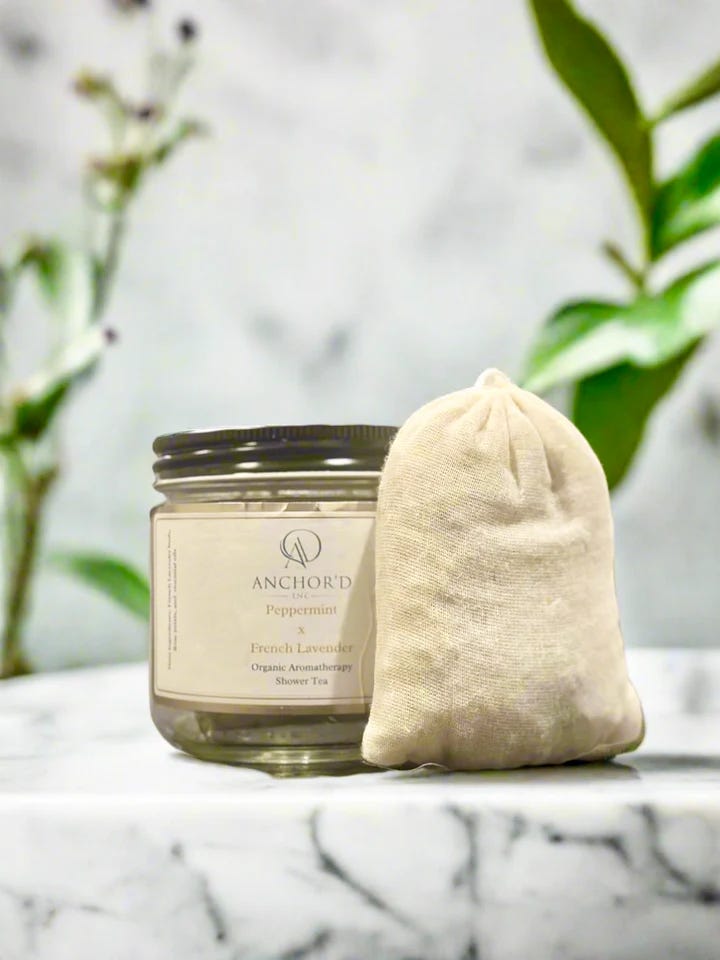

Where I volunteer, we recently hosted a winter market featuring local small businesses, and one of these, Anchor’d Inc., and its founder, Shabranae Patton, showed off an invention that really caught my eye: the shower tea! The shower tea is exactly what it sounds like: sachets of botanicals and essential oils that you can hang in your shower. The steam releases the tea’s aroma into the air, making your shower serene and sweet-smelling. Anchor’d also creates and sends post-trauma care packages to survivors of sexual assault and domestic violence—I highly recommend checking out more of their aromatherapy products!
Lingering Question
What’s a trivial issue you’re spending too much time thinking about? Is there something major beneath it that you aren’t seeing clearly? Is there something else major that could be worth putting more of your time and thought into?
Dear Readers, happy Friday! I hope you enjoyed this one! If you did, please like this post, share with a friend, and subscribe to Soul-Making, and I always love hearing your thoughts in the comments! Have a wonderful wonderful weekend.
Italo Calvino, Six Memos for the Next Millennium, translated by Geoffrey Brock, 2016.
Roland Barthes, “Cy Twombly: Works on Paper,” 1979.
Samuel Johnson, Lives of the Most Eminent English Poets, Vol. 1.



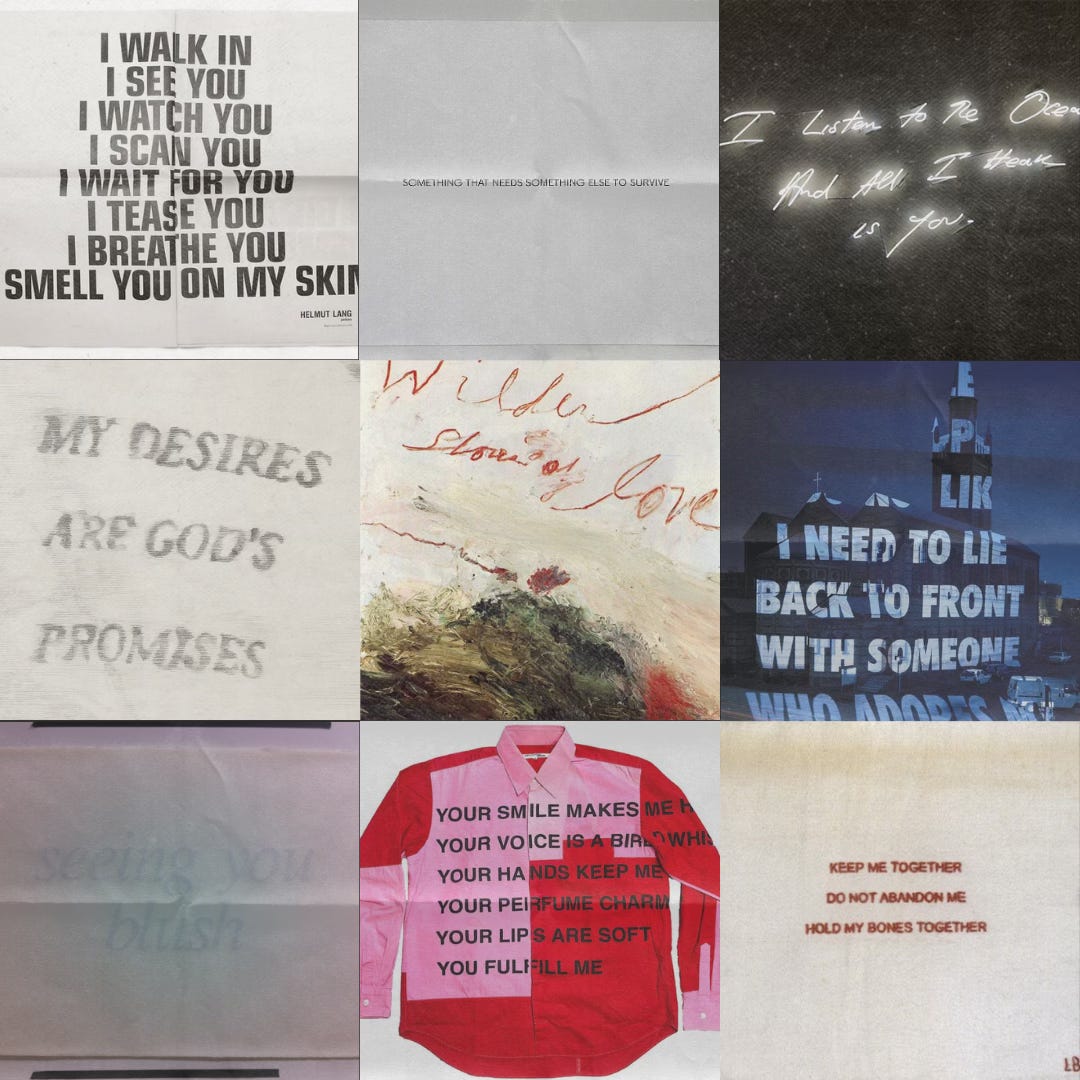


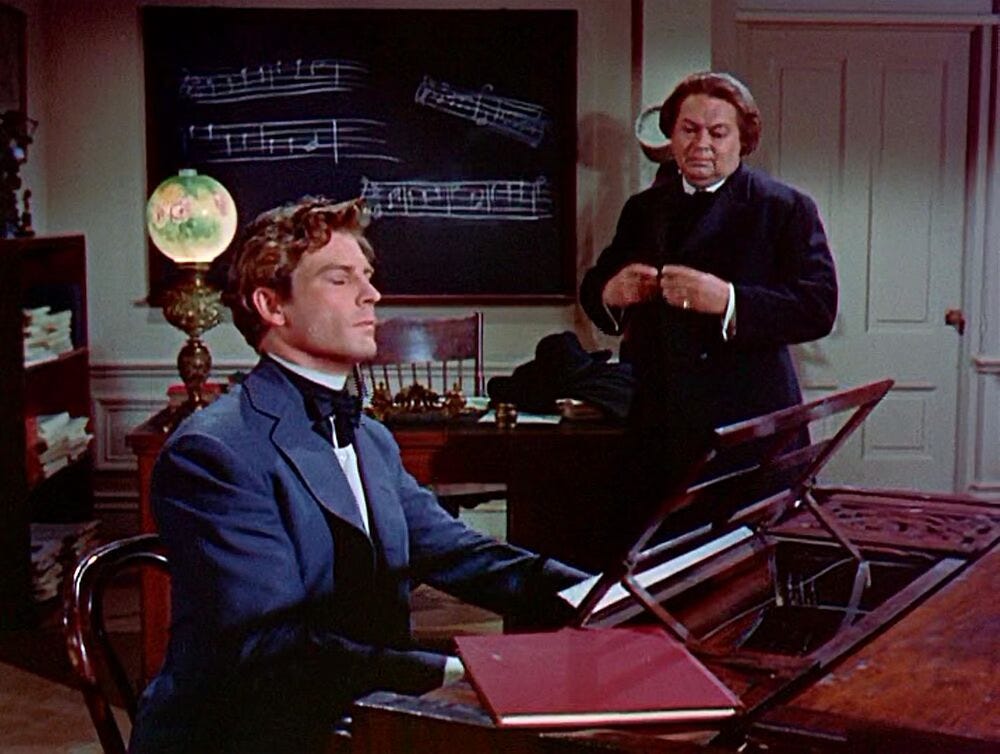


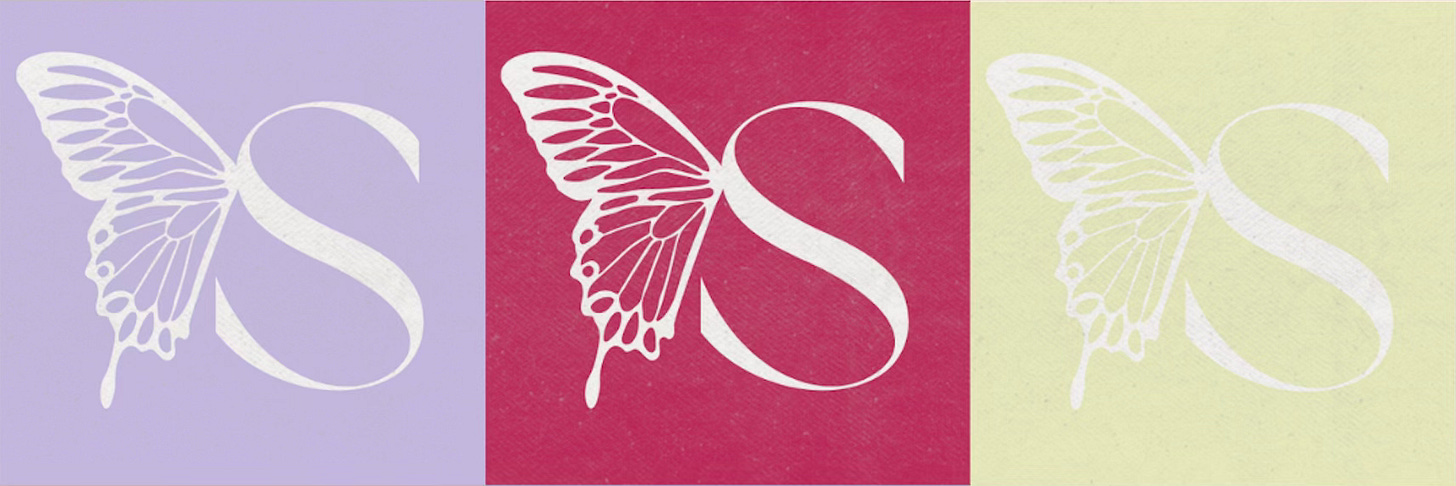
Your voice truly shines in these newsletters, you inspire me!
Well written Ramya!